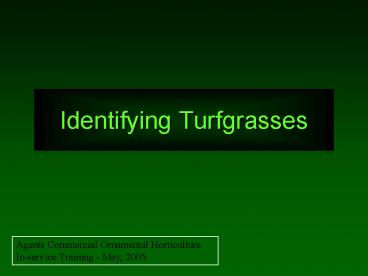Identifying Turfgrasses - PowerPoint PPT Presentation
1 / 41
Title:
Identifying Turfgrasses
Description:
Identifying Turfgrasses. Agents Commercial Ornamental ... Damp/moist, fertile ... Damp/moist, fertile soils. Poor heat/drought tolerance. Moderate ... – PowerPoint PPT presentation
Number of Views:154
Avg rating:3.0/5.0
Title: Identifying Turfgrasses
1
Identifying Turfgrasses
Agents Commercial Ornamental Horticulture
In-service Training - May, 2005
2
Common Turfgrasses in Tennessee
- Warm-season
- Bermudagrass
- Zoysia
- Centipedegrass
- St. Augustinegrass
- Cool-season
- Tall fescue
- Fine fescues
- Kentucky bluegrass
- Perennial ryegrass
- Annual ryegrass
3
Rhizomes
Turfgrass Growth Habit
Tillers
Stolons
4
Growth Habit
- Bunch spread by tillering
- Uniformity is problem long term or at low seeding
rates - Tall, Chewings and Hard Fescues, and Annual and
Perennial Ryegrasses
5
Growth Habit
- Rhizomatous
- Below-ground lateral shoots
- Storage organs
- Uniform turfs
- Sod production
- Bermudagrass, Kentucky Bluegrass, Creeping Red
Fescue and Zoysia
6
Growth Habit
- Stoloniferous
- Above-ground lateral shoots
- Foraging organ grow faster than rhizomes
- Uniform turfs
- Close mowing preferred
- Sod production
- Bermudagrass and Zoysia
7
A Turfgrass Plant
8
Vernation
Folded
Rolled
9
Leaf Tip
Pointed
Rounded
Boat-shaped
10
Ligule
11
Collar
12
Auricles
13
Tall Fescue
- Growth habit bunch
- Vernation rolled
- Ligule med.(0.4 - 1.2 mm), blunt
- Auricles short, blunt, hairs
- Collar broad, divided, short hairs
- Blade wide (5-10 mm), flat, stiff (coarse leaf)
14
- Vernation folded
- Ligule membranous, 0.5 mm, blunt
- Auricles none
- Collar narrow, continuous
- Blade 11/2 - 3 mm, often remaining folded
Red fescue
15
Hard fescue (Festuca longifolia)
- Growth habit bunch
- Very stiff leaves, wider than sheep fescue
- More tolerant of moist, fertile soils than sheep
fescue - Uses shade mixtures and soil stabilization
16
(No Transcript)
17
Poa spp.
- Most commonly used temperate grass
- More than 200 species
- Vernation folded
- Auricles none
- Leaf blade boat-shaped tip distinct central
vein parallel light veins - Growth habit bunch, stoloniferous or rhizomatous
depending on species - Cutting height 1 to 4 inches
18
Kentucky bluegrass
- Ligule membranous, very short (0.2 - 0.6 mm),
blunt - Collar broad, divided
- Leaf blades smooth, central vein, boat-shaped tip
19
Annual bluegrass (Poa annua)
- Damp/moist, fertile soils
- Sun to shade
- Major component of many golf greens
(unintentionally) and lawns often form
conspicuous patches
20
Annual bluegrass
- Ligule long (0.8 3mm), membranous, pointed
- Collar broad, divided
- Blade two - 3 mm wide light- to dark-green
ecotypes
21
Seed producer (1,190,000 seeds / lb.)
Wrinkled leaves
Long ligule
Annual bluegrass
22
Rough bluegrass(Poa trivialis)
- Growth habit stoloniferous
- Fine-textured, light green
- Damp/moist, fertile soils
- Poor heat/drought tolerance
- Moderate to heavy shade
- turns brown thins out in sun during summer
- Overseeding bermudagrass
23
Rough bluegrass
- Ligule long (2 - 6 mm) membranous, pointed or
notched - Collar broad, divided
- Blades one - 4 mm wide glossy
- surface sheath has onion-skin look
24
Rough bluegrass
Weak, small and short stolon
Rough bluegrass
25
(No Transcript)
26
Perennial ryegrass (Lolium perenne)
- English ryegrass
- Growth habit bunch
- Origin British Isles
- Annual or perennial according to location
27
Perennial ryegrass
- Vernation folded
- Ligule 0.5-2 mm, membranous, blunt to rounded
- Auricles small, claw-like
- Collar broad, divided
- Blades flat, 2-5 mm wide glossy underside
28
Other ID tips Very red at the base Seeds are
wider above the mid-point
Perennial ryegrass
Perennial ryegrass
29
Annual ryegrass
- Italian ryegrass
- Annual or short-lived perennial
- Growth habit bunch
- Vernation rolled
- Ligule ½ - 2 mm, membranous, rounded
- Auricles pointed, claw-like
- Collar broad, continuous
30
Annual ryegrass
Perennial ryegrass
31
Bermudagrass (Cynodon spp.)
- Most common southern turfgrass highly variable
- Several species and hybrids
- Common Cynodon dactylon (18 chromosomes)
- African C. transvaalensis (36 chromosomes)
- Hybrids C. dactylon x C. transvaalensis Sterile
32
Bermudagrass
- Vernation folded
- Ligule fringe of hairs
- Auricles none
- Collar continuous, narrow to broad
- Blades flat, 1.5 - 4 mm wide, smooth or hairy
above below - Growth habit stoloniferous, rhizomatous
33
Bermudagrass
34
Zoysia
35
Zoysia (Zoysia spp.)
- Three species used for turf
- Japanese lawngrass Zoysia japonica
- Manilagrass Zoysia matrella
- Mascarenegrass Zoysia tenuifolia
36
Zoysia
- Vernation rolled
- Auricles none
- Ligule fringe of hairs
- Collar broad, continuous, w/ long hairs
- Blades flat, 2-4 mm wide, stiff, long hairs on
top (bottom) - Growth habit stoloniferous, rhizomatous
37
Zoysia
pointed, stiff, upright leaves
38
Centipedegrass (Eremochloa ophiuroides)
- Moderately coarse -textured
- Stoloniferous
- Adaptation and Uses
- Coastal, southern transition zone
- Lawns, rights-of-way
- Use is increasing
39
Centipedegrass
40
St. Augustinegrass
- Coarse-textured
- Stoloniferous
- Leaf blade constricted at the base
41
(No Transcript)

